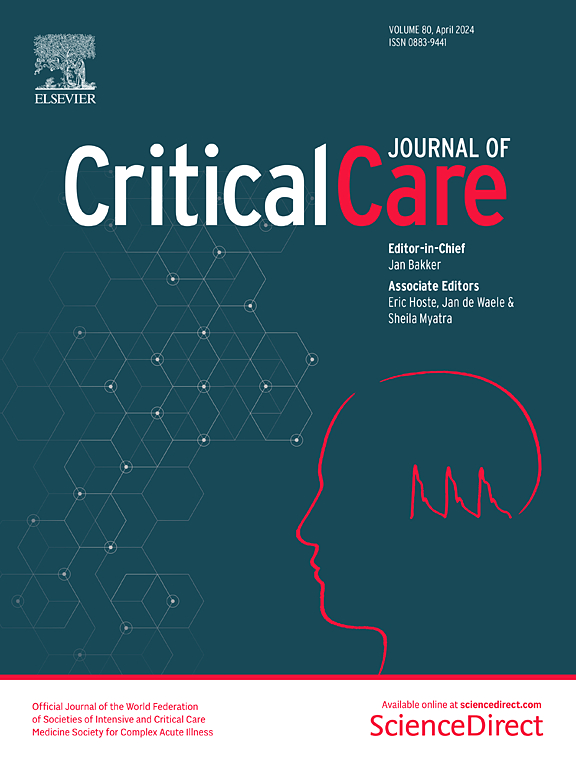中级护理单位对重症监护病房出院患者的结局和成本效益:一项全国性的回顾性观察性研究
IF 8.8
1区 医学
Q1 CRITICAL CARE MEDICINE
引用次数: 0
摘要
由于之前的研究结果不一致,中级护理病房(IMCU)对重症监护病房(ICU)出院患者的临床和经济影响仍不明确。根据日本国民健康保险计划,重症监护室按人员配置强度(高或低)进行分类。我们利用日本全国范围的住院患者数据库,对重症监护室出院患者的临床疗效和 IMCU 的成本效益进行了评估。这项回顾性观察研究使用了日本的行政数据库,以确定在 2020 年 4 月至 2023 年 3 月期间在设有重症监护病房的医院中入住高强度重症监护病房的患者。患者被分为 IMCU(IMCU 组)和普通病房(非 IMCU)两组。采用逻辑回归模型估算倾向得分,该模型包含 14 个变量,包括患者人口统计学特征和在重症监护室住院期间接受的治疗。一对一倾向得分匹配平衡了各组的基线特征。两组患者的临床结果进行了比较,包括院内死亡率、ICU 再入院率、ICU 留院时间、住院时间和医疗总费用。亚组分析中考虑了手术状态和手术区域(如心血管)。对分类变量采用卡方检验,对连续变量采用t检验进行数据分析。总体而言,162,243 名符合条件的患者被分为 IMCU 组(n = 21,548)和非 IMCU 组(n = 140,695)。倾向得分匹配产生了 18,220 对患者。与非重症监护病房组相比,重症监护病房组的院内死亡率和重症监护病房再入院率更低。然而,重症监护病房组的总费用更高。分组分析显示,在心血管[开胸]手术分组中,重症监护病房组的死亡率和总费用明显低于非重症监护病房组。与普通病房出院相比,IMCU出院与较低的院内死亡率和ICU再入院率相关。高风险亚组,如心血管手术患者,可从 IMCU 护理中获得成本效益。这些研究结果突显了重症监护病房入院与改善患者预后之间的关联,表明重症监护病房在优化资源利用方面具有潜在的作用。鉴于入院分配可能存在选择偏差,因此应谨慎解释这些研究结果。本文章由计算机程序翻译,如有差异,请以英文原文为准。
Outcomes and cost-effectiveness of intermediate care units for patients discharged from the intensive care unit: a nationwide retrospective observational study
The clinical and economic impacts of intermediate care units (IMCUs) on intensive care unit (ICU)-discharged patients remain unclear due to inconsistent outcomes in previous studies. Under Japan’s National Health Insurance Scheme, ICUs are categorized by staffing intensity (high or low). Using a nationwide inpatient database in Japan, we evaluated the clinical outcomes and cost-effectiveness of IMCUs for ICU-discharged patients. This retrospective observational study used a Japanese administrative database to identify patients admitted to the high-intensity ICU in hospitals with IMCUs between April 2020 and March 2023. Patients were categorized into the IMCU (IMCU group) and general ward (non-IMCU) groups. Propensity scores were estimated using a logistic regression model incorporating 14 variables, including patient demographics, and treatments received during ICU stay. One-to-one propensity score matching balanced baseline characteristics of each group. Clinical outcomes were compared between both groups, including in-hospital mortality, ICU readmission, length of ICU stay, length of hospital stay, and total medical costs. Surgical status and surgical area (e.g., cardiovascular) were considered in subgroup analyses. Data analyses were conducted using the chi-square test for categorical variables and t-test for continuous variables. Overall, 162,243 eligible patients were categorized into the IMCU (n = 21,548) and non-IMCU (n = 140,695) groups. Propensity score matching generated 18,220 pairs. The IMCU group had lower in-hospital mortality and ICU readmission rates than the non-IMCU group. However, total costs were higher in the IMCU group. Subgroup analyses revealed the IMCU group had significantly lower mortality and lower total costs than the non-IMCU group in the cardiovascular [open thoracotomy] surgery subgroup. Discharge to an IMCU is associated with lower in-hospital mortality and ICU readmission rates compared to general ward discharge. High-risk subgroups, such as cardiovascular surgery patients, experienced cost-effective benefits from IMCU care. These findings highlight an association between IMCU admission and improved patient outcomes, suggesting a potential role in optimizing resource use in intensive care. Given the likelihood of selection bias in admission allocation, these findings should be interpretation with caution.
求助全文
通过发布文献求助,成功后即可免费获取论文全文。
去求助
来源期刊

Critical Care
医学-危重病医学
CiteScore
20.60
自引率
3.30%
发文量
348
审稿时长
1.5 months
期刊介绍:
Critical Care is an esteemed international medical journal that undergoes a rigorous peer-review process to maintain its high quality standards. Its primary objective is to enhance the healthcare services offered to critically ill patients. To achieve this, the journal focuses on gathering, exchanging, disseminating, and endorsing evidence-based information that is highly relevant to intensivists. By doing so, Critical Care seeks to provide a thorough and inclusive examination of the intensive care field.
 求助内容:
求助内容: 应助结果提醒方式:
应助结果提醒方式:


